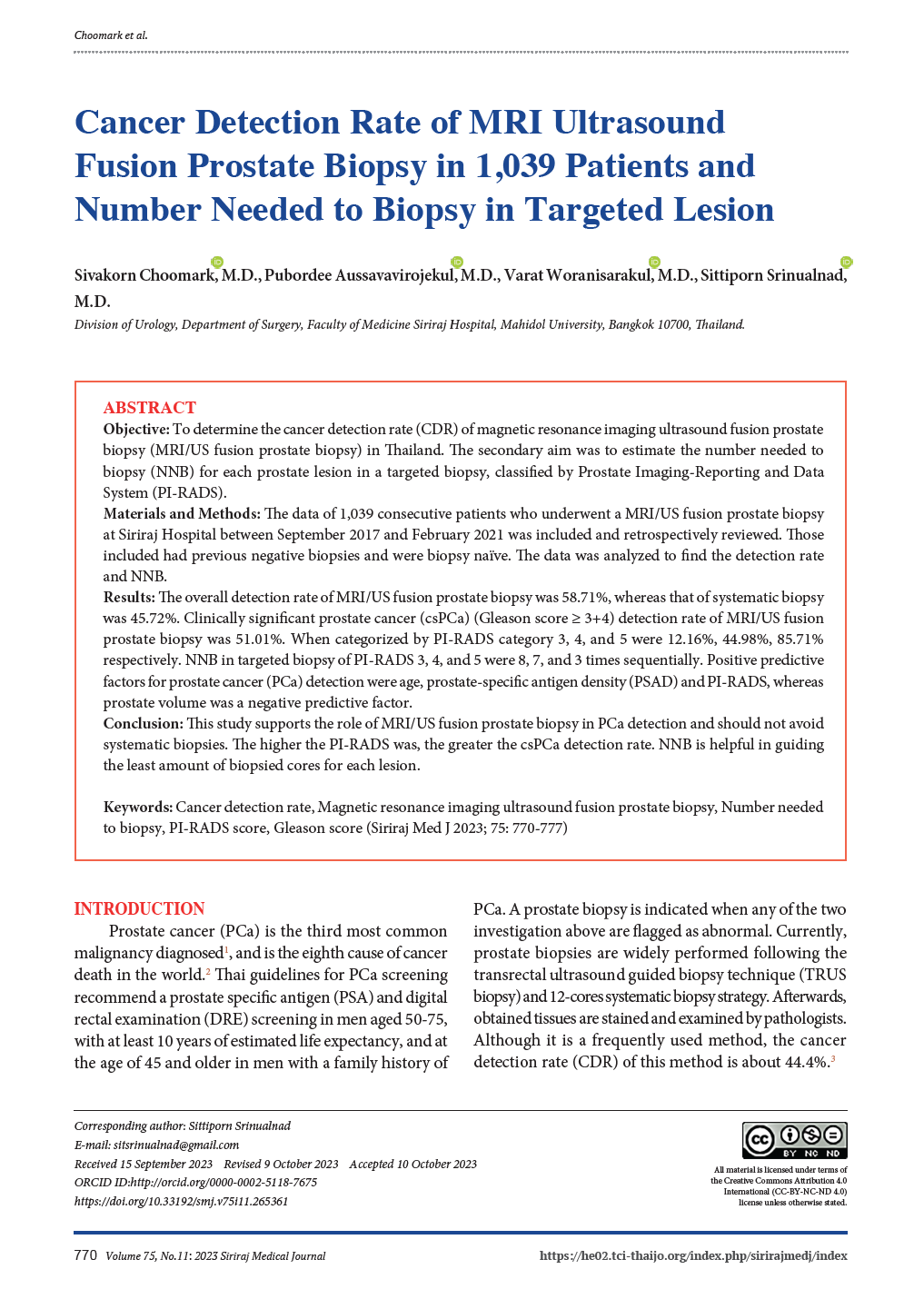Cancer Detection Rate of MRI Ultrasound Fusion Prostate Biopsy in 1,039 Patients and Number Needed to Biopsy in Targeted Lesion
DOI:
https://doi.org/10.33192/smj.v75i11.265361Keywords:
Cancer detection rate, Magnetic resonance imaging ultrasound fusion prostate biopsy, Number needed to biopsy, PIRADS score, Gleason scoreAbstract
Objective: To determine the cancer detection rate (CDR) of magnetic resonance imaging ultrasound fusion prostate biopsy (MRI/US fusion prostate biopsy) in Thailand. The secondary aim was to estimate the number needed to biopsy (NNB) for each prostate lesion in a targeted biopsy, classified by Prostate Imaging-Reporting and Data System (PI-RADS).
Materials and Methods: The data of 1,039 consecutive patients who underwent a MRI/US fusion prostate biopsy at Siriraj Hospital between September 2017 and February 2021 was included and retrospectively reviewed. Those included had previous negative biopsies and were biopsy naïve. The data was analyzed to find the detection rate and NNB.
Results: The overall detection rate of MRI/US fusion prostate biopsy was 58.71%, whereas that of systematic biopsy was 45.72%. Clinically significant prostate cancer (csPCa) (Gleason score ≥ 3+4) detection rate of MRI/US fusion prostate biopsy was 51.01%. When categorized by PI-RADS category 3, 4, and 5 were 12.16%, 44.98%, 85.71% respectively. NNB in targeted biopsy of PI-RADS 3, 4, and 5 were 8, 7, and 3 times sequentially. Positive predictive factors for prostate cancer (PCa) detection were age, prostate-specific antigen density (PSAD) and PI-RADS, whereas prostate volume was a negative predictive factor.
Conclusion: This study supports the role of MRI/US fusion prostate biopsy in PCa detection and should not avoid systematic biopsies. The higher the PI-RADS was, the greater the csPCa detection rate. NNB is helpful in guiding the least amount of biopsied cores for each lesion.
References
Srinualnad S, Hansomwong T, Aussavavirojekul P, Saksirisampant P. Paradigm Shift from Open Surgery to Minimally Invasive Surgery in Three Approaches for Radical Prostatectomy: Comparing Outcomes and Learning Curves. Siriraj Med J. 2022;74(10):618-26.
Giona S. The Epidemiology of Prostate Cancer. In: Bott SRJ, Ng KL, editors. Prostate Cancer. Brisbane (AU): Exon Publications Copyright: The Authors.; 2021.
Presti JC, Jr., O'Dowd GJ, Miller MC, Mattu R, Veltri RW. Extended peripheral zone biopsy schemes increase cancer detection rates and minimize variance in prostate specific antigen and age related cancer rates: results of a community multi-practice study. J Urol. 2003;169(1):125-9.
Boonseana S, Srinualnad S, Leewansangtong S, Tantranont N, Woranisarakul V. Prostate cancer detection rate using MRI/ultrasound fusion-guided prostate biopsy in Siriraj Hospital. Insight Urology. 2022;43(2):128-33.
Benelli A, Vaccaro C, Guzzo S, Nedbal C, Varca V, Gregori A. The role of MRI/TRUS fusion biopsy in the diagnosis of clinically significant prostate cancer. Ther Adv Urol. 2020;12:1756287220916613.
Hansen NL, Kesch C, Barrett T, Koo B, Radtke JP, Bonekamp D, et al. Multicentre evaluation of targeted and systematic biopsies using magnetic resonance and ultrasound image-fusion guided transperineal prostate biopsy in patients with a previous negative biopsy. BJU Int. 2017;120(5):631-8.
Kasivisvanathan V, Rannikko AS, Borghi M, Panebianco V, Mynderse LA, Vaarala MH, et al. MRI-Targeted or Standard Biopsy for Prostate-Cancer Diagnosis. N Engl J Med. 2018;378(19):1767-77.
Sitthinamsuwan P, Ratanarapee S, Leewansangthong S, Senawong S. Correlation between Gleason Scores of Prostatic Biopsies and Radical Prostatectomy Specimens. Siriraj Med J. 2009;61(1):13-5.
Wegelin O, Exterkate L, van der Leest M, Kummer JA, Vreuls W, de Bruin PC, et al. The FUTURE Trial: A Multicenter Randomised Controlled Trial on Target Biopsy Techniques Based on Magnetic Resonance Imaging in the Diagnosis of Prostate Cancer in Patients with Prior Negative Biopsies. Eur Urol. 2019;75(4):582-90.
van der Leest M, Cornel E, Israel B, Hendriks R, Padhani AR, Hoogenboom M, et al. Head-to-head Comparison of Transrectal Ultrasound-guided Prostate Biopsy Versus Multiparametric Prostate Resonance Imaging with Subsequent Magnetic Resonance-guided Biopsy in Biopsy-naive Men with Elevated Prostate-specific Antigen: A Large Prospective Multicenter Clinical Study. Eur Urol. 2019;75(4):570-8.
Marchetti MA, Yu A, Nanda J, Tschandl P, Kittler H, Marghoob AA, et al. Number needed to biopsy ratio and diagnostic accuracy for melanoma detection. J Am Acad Dermatol. 2020;83(3):780-7.
Ahdoot M, Wilbur AR, Reese SE, Lebastchi AH, Mehralivand S, Gomella PT, et al. MRI-Targeted, Systematic, and Combined Biopsy for Prostate Cancer Diagnosis. N Engl J Med. 2020;382(10):917-28.
Siddiqui MM, Rais-Bahrami S, Turkbey B, George AK, Rothwax J, Shakir N, et al. Comparison of MR/ultrasound fusion-guided biopsy with ultrasound-guided biopsy for the diagnosis of prostate cancer. JAMA. 2015;313(4):390-7.
Rouvière O, Puech P, Renard-Penna R, Claudon M, Roy C, Mège-Lechevallier F, et al. Use of prostate systematic and targeted biopsy on the basis of multiparametric MRI in biopsy-naive patients (MRI-FIRST): a prospective, multicentre, paired diagnostic study. Lancet Oncol. 2019;20(1):100-9.
Rastinehad AR, Turkbey B, Salami SS, Yaskiv O, George AK, Fakhoury M, et al. Improving detection of clinically significant prostate cancer: magnetic resonance imaging/transrectal ultrasound fusion guided prostate biopsy. J Urol. 2014;191(6):1749-54.
Borkowetz A, Platzek I, Toma M, Laniado M, Baretton G, Froehner M, et al. Comparison of systematic transrectal biopsy to transperineal magnetic resonance imaging/ultrasound-fusion biopsy for the diagnosis of prostate cancer. BJU Int. 2015;116(6):873-9.
Walton Diaz A, Hoang AN, Turkbey B, Hong CW, Truong H, Sterling T, et al. Can magnetic resonance-ultrasound fusion biopsy improve cancer detection in enlarged prostates? J Urol. 2013;190(6):2020-5.
Al-Khalil S, Ibilibor C, Cammack JT, de Riese W. Association of prostate volume with incidence and aggressiveness of prostate cancer. Res Rep Urol. 2016;8:201-5.

Published
How to Cite
License
Copyright (c) 2023 Siriraj Medical Journal

This work is licensed under a Creative Commons Attribution-NonCommercial-NoDerivatives 4.0 International License.
Authors who publish with this journal agree to the following conditions:
Copyright Transfer
In submitting a manuscript, the authors acknowledge that the work will become the copyrighted property of Siriraj Medical Journal upon publication.
License
Articles are licensed under a Creative Commons Attribution-NonCommercial-NoDerivatives 4.0 International License (CC BY-NC-ND 4.0). This license allows for the sharing of the work for non-commercial purposes with proper attribution to the authors and the journal. However, it does not permit modifications or the creation of derivative works.
Sharing and Access
Authors are encouraged to share their article on their personal or institutional websites and through other non-commercial platforms. Doing so can increase readership and citations.














